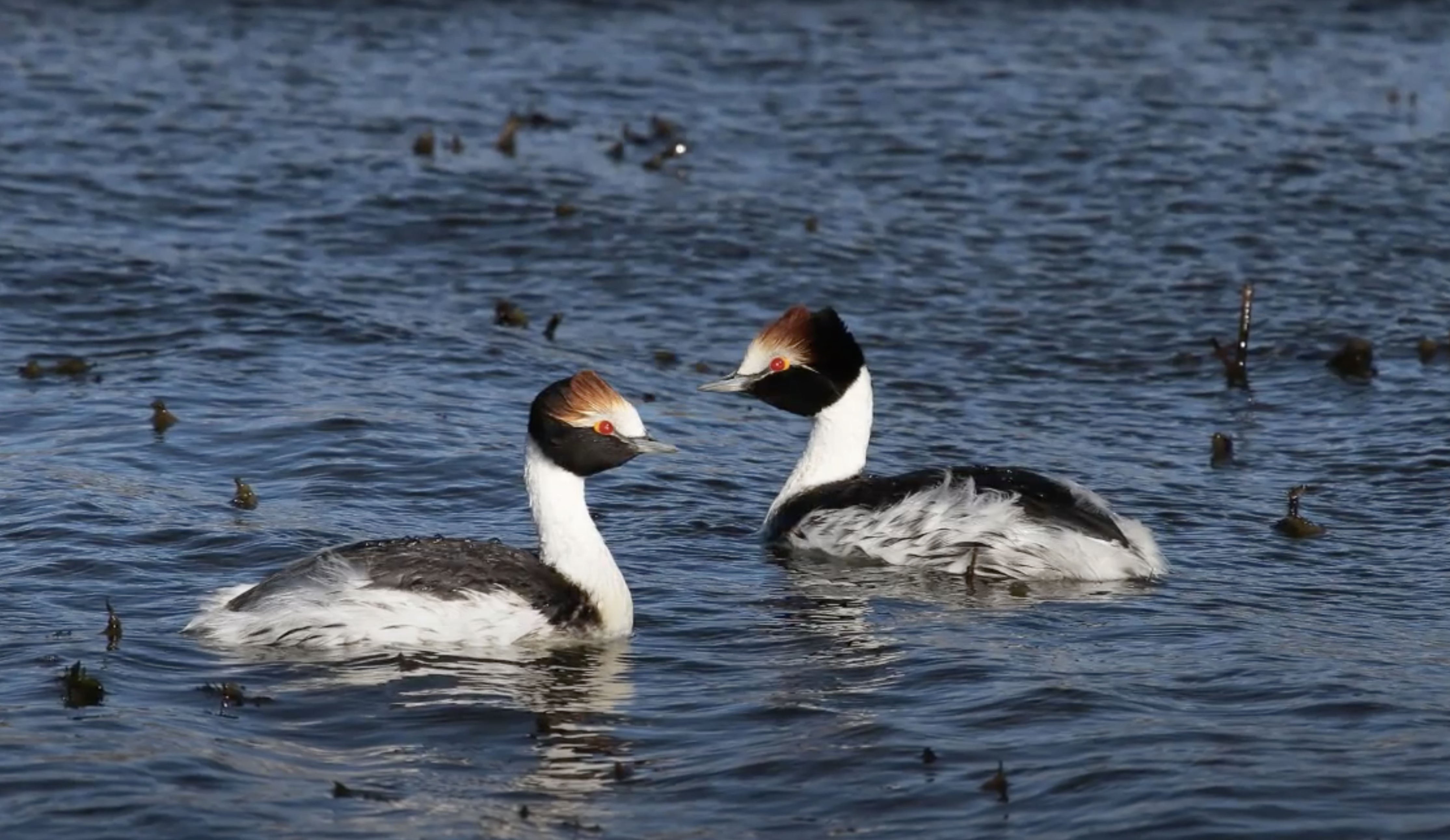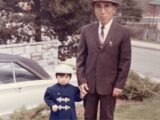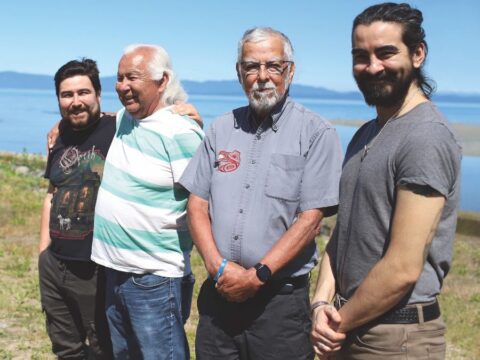Editor’s note: Broadview first published this story in 2013.
Does the fate of a tiny, quizzical, picky, jaunty, crimson-eyed, migrating, night-flying, snail-eating, lagoon-living and horribly threatened water bird that lives only in the outback of Patagonia matter?
You may unsubscribe from any of our newsletters at any time.
It matters to the bird, of course, in this case the hooded grebe of Argentina’s windswept plateaus. Only about 800 remain after a recent wholesale population collapse — the result of a toxic combination of human-made threats — making it one of the most critically endangered birds on the planet. Its birth rate over several recent years has been zero, a hallmark of the living dead.
But does it matter to us? If we, like the ancient Sisters of Fate, snip the hooded grebe’s thread of life, killing off a creature that painstakingly, chaotically, maybe randomly evolved over billions of years from a single-celled entity to a heart-tuggingly beautiful bird with a scarlet crest, are we diminished? Or here’s another thought: are we at risk too? Is the snipping of one thread a prophecy for the indiscriminate snipping of many?
I have come to the toe of South America to find out. Two years ago, not so far from here on a ship sailing to Antarctica, I met Santiago Imberti, one of the world’s experts on the hooded grebe and, it could fairly be said, the reason the bird is alive to this day. I had given a talk on board about global ocean change and the frightening phenomenon of ocean acidification, caused by the high carbon dioxide concentrations we have put into the atmosphere. The following morning he came up to me, haggard, and said he hadn’t slept all night. He’d been thinking about the mysterious decline of the hooded grebe, wondering if changes to ocean chemistry might have something to do with it. The whole, desperate story of the bird tumbled out, and my urge to find out more began.
It takes us two years and dozens of e-mails to pin down a week we can spend together on our quest for the hooded grebe. I land in Argentina just before Christmas. It’s summer in the southern hemisphere and the start of the hooded grebe’s uncertain breeding season, the very one that might determine its ultimate life or death. I have flown halfway around the world, from frozen Toronto through a horrific lightning storm into Buenos Aires, and then more than 2,600 kilometres further south to Rio Gallegos (pronounced Hash-eh-gas), the capital city of Santa Cruz province in fabled Patagonia, to meet Imberti.
And then, there he is. More sunburned than I remembered, brown eyes more twinkly under his peaked cap, flashing a huge smile as he greets me at the arrivals door and then strides outside to his truck, where I toss in my backpack. The two of us are going to spend five days in this truck, he explains, driving for hours on end through the wilds of Patagonia, eating and drinking from supplies he’s laid in, tracking the strange trail of the hooded grebe. The first stop is here, in Rio Gallegos, city at the bottom of the world.
Rio Gallegos is where the hooded grebe story really begins because, in many important ways, the story of the grebe is also the story of Imberti. He grew up here, a kid smitten with wildlife in this sleepy, stubby city of 100,000 spread along an estuary on the Atlantic Ocean in Argentina’s deep south. As he wheels through the streets toward a newly built education centre, part of an urban wildlife reserve he helped set up for the bird, he points to the waters of the estuary.
In 1997, back home after finishing his ornithological studies in Buenos Aires, Imberti was here at the estuary drinking maté (the communally sipped herbal tea infusion that is Argentina’s cherished national drink), when he spotted a few hooded grebes. He knew the birds only inhabited the Santa Cruz province of Patagonia. But how many lived in the estuary? How long did they stay before moving to their summer breeding sites further north on the vast Argentine plateaus? Where else did they winter? He realized that hardly anything was known about the bird.
So he started looking. Idle curiosity. The estuary is a biologically weird place, featuring one of the most extreme tides in the world. Imberti watched and took notes, sipping maté, as the hooded grebes moved in and out on the tides. He started looking in other estuaries and counting the birds, marking 50 outings in seven years.
More on Broadview:
- Exploring the world’s oldest creation story in northern Australia
- Lac La Croix pony saved from extinction by the Ojibwe
- 5 things you’ll find in this birder’s tool kit
But even as he explored two more wintering places on the Atlantic coast, he found fewer and fewer hooded grebes. That’s when he knew something was wrong.
By this time, we’re at the education centre, and I rush to look out the broad picture window with a view of the estuary, in the off chance that a lone hooded grebe has stayed behind. No. The birds have long since flown. They’re on their yearly trek to the Patagonian steppes to make their peculiar nests, breed and, if all goes well, hatch some chicks. The quest to find one is just beginning.
Extinction, like death, is forever. It’s also, as the scientific wags like to say, one of life’s certainties: it’s not a question of if, but when. About 99 percent of the four billion or so species that have ever existed have gone extinct. But unlike the death of an individual, one of a group that is still capable of reproducing, the death of a species means that its genetic pool dries up, never to be passed down. It means all those billions of years of sweaty evolution are lost forever. It is, in every possible sense of the word, a tragedy.
And just because it’s inevitable doesn’t mean it should be imminent. Most life evolves to stay for a while. Apart from the five mass extinctions the planet has withstood over the past 3.5 billion years of life on Earth, extinction tends to be a sedate and casual affair rather than a train wreck. One species dies off after a leisurely stint on the planet; one or two others, sometimes more complex, come to life, usually taking millions of years to emerge.
The stunning revelation is that, today, Homo sapiens is putting extinction on fast-forward. Without quite knowing what we are doing or what it will mean, we are ripping whole pages from the book of life, swiftly thrusting the planet toward the edge of the sixth extinction event. The spasm of extinction that wiped out the dinosaurs 65 million years ago, and 76 percent of species in all, took place over a period of 2.5 million years. The Permian “Great Dying” of 250 million years ago, which forced 96 percent of species into oblivion, took as long as 2.8 million years to unfold. Today, when scientists talk about how fast we are forcing species into genetic perdition, they talk about centuries. In the case of the elusive hooded grebe, it is decades, if not years.
There are a raft of reasons for present excesses, ranging from our transformation of grasslands into farmlands; letting species from one continent loose in another; polluting the land, water and air with toxins; killing creatures for meat or fun; cutting down trees; and changing the chemistry of the atmosphere and ocean with carbon-based gases from burning fossil fuels — the dead of another era. At least a quarter of mammals today are at risk of extinction and 41 percent of amphibians, according to the latest count by the International Union for Conservation of Nature, the official record keeper of the dead and dying. For many creatures, like insects, fish, lichens, ferns, mosses and reptiles, we just don’t have enough information to make good estimates.
But based on these numbers and analysis of the legion of creatures we know have gone extinct in the past few hundred years, biologists including Stuart Pimm of Duke University in Durham, N.C., have calculated that today’s pace of extinction is anywhere from 100 to 1,000 times as fast as it has been for most of the past billions of years.
And then there are birds. Because they’re so showy, so studied, so beloved — they are, as author Terry Tempest Williams recently wrote in Audubon Magazine, “mediators between heaven and earth” — we know more about the 10,000 bird species on Earth than we do about most of the planet’s creatures. About 13 percent of bird species are under threat right now. The normal, historic rate of extinction for birds is one a century, Pimm calculates. But we’ve actually lost 151 bird species in the past 500 years, including the passenger pigeon and the dodo, instead of the normal five. By the end of this century, Pimm reckons 1,800 bird species will go extinct if trends continue.
Records show that the pace is already picking up. We lost 19 bird species in the last quarter of the 20th century alone, including the brilliant blue Spix’s macaw of Brazil, and likely another three in the dozen years since this century began. Birds teetering right on the precipice of extinction — dubbed critically endangered, which means a single bad breeding season, a single outbreak of disease, a single new predator can kill them off forever — have surged in number from 168 in 1996 to 197 last year, a jump of more than 17 percent. Among the most recent additions to the list is the hooded grebe.
Imberti and I are heading inland from the coast at the tip of South America, plotting a route north and so far west that we will almost reach the border of Chile, tracing by road the path the hooded grebe takes when it flies north to nest. The bird is one of those uneasy compromises of evolution, Imberti tells me: a superb swimmer and diver, a graceless flier.
We’re aiming for El Sauco, the 35,000-hectare farm that is the epicentre of the bid to save the hooded grebe. Imberti and the non-profit group Ambiente Sur have raised $2 million to buy the derelict farm, part of a fledgling dream to start a national park in the heart of hooded grebe breeding territory. Already, a team of volunteers from all over the world is gathered doggedly at the farm to track the grebes’ progress this season.
Patagonia is empty, austere, filled with the sharp scents of verbena and wind. You can drive for hours through abandoned sheep farms so big that each one is marked on my map, meeting nothing but herds of buff-coloured South American llamas, or guanacos. Like small humpless camels, they race through the land, heads comically high, ears alert, jumping merrily over wire fences. Every now and again, we see a guanaco corpse hung up and rotting on a fence, a jump that went wrong. But for every lost creature, we spot hundreds thriving, including wobbly newborns just finding their running legs.
The hooded grebe was discovered by accident, Imberti tells me as he drives. In 1974, the famed Argentine ornithologist Maurice Rumboll and a student pulled up beside a lagoon and shot a bird they thought was another, common species of grebe. The student waded out to get it, contracting hypothermia in the process. He threw it in the back of the truck and headed to the hospital. Later, Rumboll opened the bag and couldn’t believe his eyes: a new species of grebe — dubbed the hooded grebe — and one of just 20 birds found only in Argentina. Celebrations ensued.
“Stubbornness is their main tool for survival.”
Until Imberti started looking, scientists who had been counting the birds reckoned there was a stable global population — all in Patagonia — of 4,000 to 5,000 individuals. But, alarmed by his declining winter counts, Imberti was clamouring for more information. In January 2009, he set off on a mission to examine the 60 most important lagoons the hooded grebe nested on during the 1980s. He found fewer than 550 birds.
It was a huge wake-up call. By the next summer’s breeding season, he’d assembled four teams to examine 200 lakes; by the year after, they were doing winter counts as well. The findings were disastrous. In the two years, only 28 nests hatched chicks, but no chicks survived. Not only that, but they found no juvenile hooded grebes, a sign that no chicks had been born in the years before. In all, the teams estimated a population of about 800 birds in 2011, a decline of at least 80 percent from the 1980s. As a result of his work, the bird’s status dropped two full categories on the world’s endangered species list, from “vulnerable” to “critically endangered.” That’s a single category away from “extinct in the wild.”
So what’s killing off the hooded grebe? It’s as if all the malicious gods of the universe have conspired against the creature. For one thing, the birds are, as Imberti says, “narrow-minded.” They will only breed in certain types of lagoons on the Patagonian plateaus, which have to have to be deep, but not too deep. The lagoons have to have crystal-clear water and contain a certain red-tinged milfoil water plant growing up from the bottom of the lake, both relatively rare. Plus, they have to have enough of the milfoil for the grebes to make their nests, but not so much that the birds can’t forage for the snails they eat that also live on the milfoil.
Their floating nests are a source of scientific wonder, tethered for stability to the bottom of the lagoon by living stems of milfoil, reinforced by fibres the birds rip from other plants and wrap around the stalks to make a column that runs down through the water. This protects the nests against savage plateau winds and waves. It’s also one of the reasons this grebe can’t be bred in captivity.
Alas for the hooded grebe, high carbon dioxide concentrations in the atmosphere are drying up the lagoons and causing ever-higher winds. Temperatures have risen about two degrees Celsius over 300 years. There’s less rain and less snow. As a result, there are only a handful of suitable lagoons left for the birds to colonize, and nests frequently get torn to pieces by the winds.
Not only that, but rainbow trout, introduced to Patagonia for fish farming in the early 1900s, are fouling the lakes and chasing away waterfowl, especially on the Strobel Plateau, once key breeding ground for hooded grebes. In some cases, large trout have been known to eat chicks. Because fish farms result in great amounts of fish waste, the number of kelp gulls on the plateaus has also increased, and they are keen hunters of hooded grebes.
Perhaps worst of all, the lagoons and rivers of the Patagonian plateaus are infested with American mink, imported here from North America by would-be fur farmers who released the creatures into the wild when their businesses failed. Mink are remorseless hunters, one of the few animals in the world that kill for the fun of it rather than for necessity. And the hooded grebe, unused to predators from below, has no fear of them, simply looking on with mild curiosity as the minks swim up, lunge and kill them by biting off chunks of their head and brain.
Two years ago, to Imberti’s horror, he and his colleagues found a mink in one of the grebes’ most important breeding lagoons. That sole animal marauded through a whole colony of nests, killing 33 hooded grebes at a single go. One of the great questions is whether the mink will make a return appearance this year. If it does, Imberti tells me, that would spell catastrophe.
On the positive side, if the hooded grebe finds a suitable lagoon, avoids trout, kelp gulls, mink, winds and waves, it will pluckily keep laying eggs in the same nest from December until late March in a bid to get a live chick.
“Stubbornness is their main tool for survival,” Imberti says, chuckling.
On the negative side, if it lays two eggs and one hatches first, it abandons the second, a heartbreaking habit for a creature so close to the edge.
We’re about halfway to El Sauco — starting the third day of our journey now — and have long since left paved roads and telephone signals behind. Last night, we slept at a sheep farm, La Angostura, that is also a mecca for birders. It features a man-made marsh and 1,200 species of birds right outside the farmhouse door.
Five minutes away is Tomchi Lake, a tiny lagoon that sometimes serves as a resting pond for hooded grebes on their way north. Imberti and I had stopped there the evening before, scanning it anxiously for birds. None. We pull up again this morning, and Imberti whips out his binoculars. “And there’s a hooded grebe,” he tells me, seconds later. “In fact, two.” They arrived in the night, likely a couple.
I watch, transfixed. They are bobbing, diving, calling to each other. Much smaller than the North American ducks I’m used to, they stand out at a distance because their bodies are white, crests red, chins inky black. There are as few as 200 breeding pairs of hooded grebes on the planet, and we’re watching one of them. These two look like they’re on a grand adventure, having fun. And perhaps they are, participants in the undying game of trying to pass on DNA.
Many hours later, we arrive at El Sauco. The team of scientists is still in the field. Imberti brews up some maté for us to share, and we try to unkink after days of driving on hip-wrenching roads. Then the team arrives, dust kicking up from their truck tires.
Ignacio “Kini” Roesler, slim and ponytailed, jumps out to greet Imberti. His face is ashen. Mink, he says. They’ve found mink in one of the breeding lagoons. One hooded grebe is dead on its nest and another is injured.
Imberti looks like he’s been kicked in the stomach.
Part 2: How a small bird touched a global nerve.
Alanna Mitchell is an award-winning journalist and science writer in Toronto.













